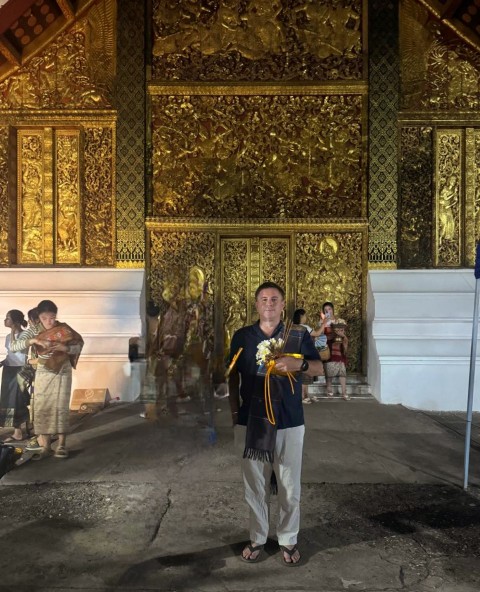
Watering the ພະມານ Buddha at Wat Xieng Thong
The evening air carries the sweet scent of frangipani as I walked towards Wat Xieng Thong. This beautiful 16th-century temple complex, one of Luang Prabang’s most revered religious sites, is particularly busy today as locals and visitors gather for a special occasion.

It’s mid-April in Laos, and the annual Pimai Lao (Lao New Year) celebrations have just finished across the country. The streets erupt in joyful water fights during this time, within temple grounds, water takes on a far more sacred significance.
The Sacred Ritual
Inside the ornate sim (ordination hall) of Wat Xieng Thong stands the revered ພະມານ “Phanum” Buddha image. During Pimai Lao, the Buddha image undergoes a ritual cleansing called the “Song Nam Phra.” This ceremonial bathing represents purification and renewal for the coming year. Devotees line up with small silver bowls of water, often infused with flowers or perfume, waiting for their turn to gently pour water over the Buddha statue.
We buy long candles, incense sticks, perfumed water and Dok Champa flowers outside from a lady selling these on the street. We enter the temple and put our scarves on and prepare our offerings.

I approach the statue light my candles and stick them to the metal railings, set my 3 incense sticks alight and raise my bowl to my forehead and make a prayer. After I join the long line of people waiting the walk up to the Naga that is used to pour water. There are the usual people who push in front of us, like everywhere, Lao people are not always polite. People around me comment about them. The water in my bowl is flecked with jasmine petals, releasing a subtle fragrance. It’s my turn to walk up the few steps and pour the water from my bowl. The water will later be distributed as it’s believed to carry blessings.


Yet there’s something deeply moving about the contrast between the exuberant celebrations outside and the quiet reverence within the temple. Both expressions—the rowdy water fights and the gentle ceremonial bathing—share common themes of cleansing, renewal, and community.
Historical Significance
The Phra Bang Buddha has a complex history that mirrors Laos’s own tumultuous past. Legend has it that the statue was a gift from Cambodia, though it has travelled to Thailand and back during various conflicts and power shifts in Southeast Asia. Its presence at Wat Xieng Thong during the April ceremonies connects modern worshippers to centuries of tradition.
I am now ready for the year ahead.
Laos, Luang Prabang, Monks, Temple
Comments RSS Feed